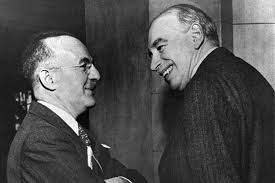Keynes Hayek by Nicholas Wapshott, WW Norton, 2011, 382 pp.
In one of those delicious coincidences that history sometimes throws up, two of the greatest economists of the twnethieth century took turns on the roof of Kings College to watch out for Nazi planes intent on bombing the venerable ivory towers of Cambridge University. The Nazi bombers never came. Nevertheless, in 1942, when John Maynard Keynes and Frederick Hayek took their turn as firemen on the roof, they used those quiet hours to plan the new economic order that each hoped would dominate the post-war world.
Keynes at the time was working for the Chancellor of the Exchequer. A wealthy man, he took no salary, instead considering his work as noblesse oblige. Hayek, too, would have loved nothing more than to contribute to the war effort. However, as an Austrian, he was not trusted, and his numerous efforts to get a job with the government were rebuffed.
So while Keynes immersed himself in the war effort, Hayek planned another battle, which he called the “war of ideas.” During the 1930s, Keynesian economics had become the orthodoxy, in which government priming demands was considered the best way to deal with economic downturns. That meant governments pumping money into the economy, printing more as necessary to stimulate necessity for goods and services. In the wake of the Great Depression, this remedy was picked up by many Western governments and historians who believed that Keynes’s economic ideas would lift the world out of the Depression. Hayek, however, disagreed. During the 1930s, he engaged in running battles with Keynes, in which he argued that the markets, if allowed to run free, would sort out the peaks and troughs of the economy. Moreover, he argued that government interference had worsened and prolonged the Depression.
In the wake of the global financial crisis, the debates on the role of governments in managing the economy could not be more relevant. In Keynes Hayek, Nicholas Wapshott not only replays many of the arguments between Hayek and Keynes, but also brings these two men to life. The picture he provides throws up some surprises.
Keynes was a complex character, whose mercurial intellect overwhelmed those he met. Even Hayek was intimidated by Keynes. Recalling his first meeting, Hayek explained, “He had a habit of going like a steamroller over a young man who opposed him. But if you stood up against him, he respected you for the rest of your life. We remained, although we differed in economics, friends till the end.” Hayek did stand up to Keynes, and they became unlikely friends. And so, while Hayek regarded Keynes as a mediocre economist, he stood in awe of his intellect, even expressing admiration for his books for “their outspokenness and independence of thought.” Although Keynes died in 1946, Hayek continued to wage his war of ideas, and by the 1980s, the neoliberals, who accepted Hayek’s free-market ideas, were in the ascent in both London and Washington. Since the onset of the global financial crisis, the conflict between the ideas of these two great economists has gained new relevance.
Wapshott’s book strips away the mythologies that have grown up around these two men, promoted by left- and right-wing ideologies. We discover that Keynes did support the free market and believed that governments should only intervene in extraordinary circumstances. He shone in business, and his investments made him a very wealthy man. Hayek, on the other hand, never worked outside academia and was hopeless in managing his financial affairs.
For me, perhaps the most surprising discovery was that Hayek was not opposed to social welfare, and had he been alive today, may even have supported “Obamacare.” Writing in 1944 in The Road to Serfdom, Hayek remarked that wealthy nations could afford to provide their citizens with “a comprehensive system of social insurance in providing for those common hazards of life against which few can make adequate provision.”
Wapshott does an excellent job bringing both men to life. While it takes little to show Keynes as a larger-than-life figure, the author has done an outstanding job in seeking out interesting anecdotes on Hayek, who is a much duller character. Although the author tries to be even-handed, Keynes is really the star of this book.
If the book has a fault, it is the lack of attention to Keynes’s contribution to Bretton Woods, which Wapshott devotes a bare half-dozen pages. Nor is there any mention of Hayek’s reaction to Keynes’s model of a new economic order. In light of the spread of globalization, Wapshott failure to discuss the last chapter of The Road to Serfdom is titled “The Prospects of International Order.” Is inexplicable
Wapshott also fails to describe how Hayek helped forge a generation of ideological warriors who championed free-market economics and overturned the Keynesian orthodoxy. While Wapshott does mention the Mont Pelerin Society, he neglects to give an account of Hayek’s influence over Antony Fisher, who created a model for a neoliberal think-tank that was replicated in the US, UK, and other western countries and should be credited with inspiring the free-market policies of Ronald Reagan and Margaret Thatcher.
At the end of the book we see that Hayek lived in the ivory tower of theories, which made his ideas ill-adapted to the world of practical policies. While he lived to see the Thatcher and Reagan neoliberal revolutions, he never took credit for them. Too much of a purist, he felt that his ideas were never taken seriously. On the other hand, Keynes was the ultimate pragmatist. When questioned on his lack of consistency, Keynes replied: “When the facts change, I change my mind. What do you do, sir?” Now that we live in an uncertain world where circumstances constantly evolve, I think I would rather have a dose of Keynes’s pragmatism than one of Hayek’s purist economic prescriptions.

